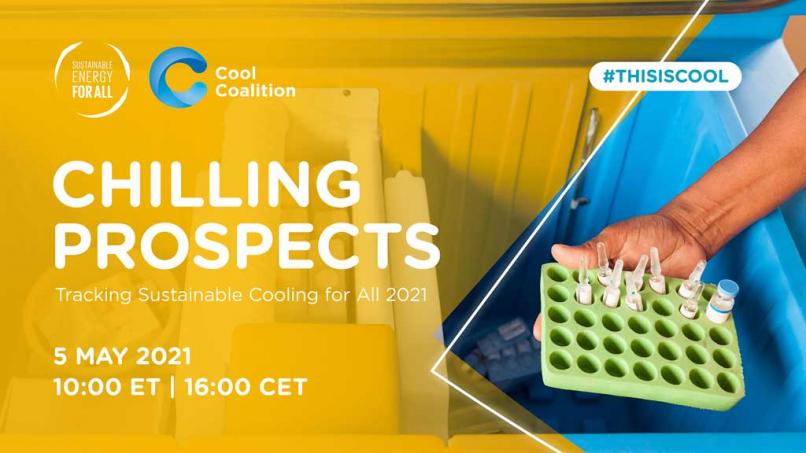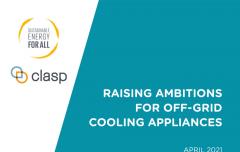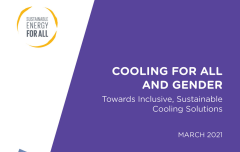Global Cooling Prize: A Pathway to Net-Zero Residential Cooling by 2050
By Ankit Kalanki and Caroline Winslow, RMI
|
Two technologies that deliver cooling with over 5 times lower climate impact On 29 April, RMI announced not one, but two grand winners of the Prize — Gree Electric Appliances, Inc. of Zhuhai with partner Tsinghua University; and Daikin with partner Nikken Sekkei Ltd. Both teams showcased that breakthrough cooling technologies are not only possible, but here today. |
The Global Cooling Prize—a journey that began back in 2018—is now in its final stretch: the winner(s) will be announced during the virtual Grand Award Ceremony on 29 April. Over the past two and half years, the Prize has received an incredible response from government institutions, global nonprofit organizations, innovators, and air conditioner (AC) manufacturers alike. It has inspired entrepreneurs to start their own ventures in the cooling space and has motivated the incumbents to rethink what is possible.
But that’s not all—the Prize has also served as a catalyst to shatter the performance ceiling of AC units and bring the goal of net-zero residential cooling within reach.
How we got here
In 2017, RMI decided that it was time to transform the way we provide cooling. We recognized then that population growth and urbanization, coupled with a warming planet, would cause an exponential rise in future demand for cooling, particularly in the residential sector of developing countries.
The next year, RMI launched the Global Cooling Prize in partnership with the Department of Science and Technology (DST) of the Government of India and Mission Innovation. The Prize called on innovators, entrepreneurs, and industry leaders from around the world to design a residential room air conditioner (RAC) with at least five times lower climate impact and no more than two times the cost of standard AC units already on the market.
Over the past two and half years, researchers and companies from around the world have responded enthusiastically to the challenge. Over 2,100 teams from 96 countries registered for the Prize. Of these, 139 teams, comprising individuals, research labs and universities, startup companies, and AC manufacturers, submitted detailed technical applications. In November 2019, following review by the Prize’s Technical Review Committee, the coalition announced eight Finalist teams and awarded them USD 200,000 each to support the development and delivery of two working prototypes to the Prize’s testing facilities in India.
In October 2020, we began putting prototypes to the test in hot and humid conditions in a lab environment simulating full-year climatic conditions and in an actual apartment building in India. We also tested the prototypes under the Indian testing standard to determine their seasonal energy efficiency rating. The rigorous testing phase concluded in March 2021 with four teams having successfully completed both the lab and field tests.
A number of teams’ prototypes shattered the performance ceiling for AC units, exceeding what was previously believed to be possible. Multiple teams also showed that it is possible to safely shift away from traditional refrigerants, which are potent greenhouse gases, and instead use new refrigerants that have ultra-low global warming potential (GWP)—without negatively impacting performance. By demonstrating breakthrough RAC technologies that can dramatically lower energy consumption and use ultra-low-GWP refrigerants, the Prize has served as a catalyst to bring the important goal of net-zero residential cooling within reach.
The goal of net-zero cooling
A growing body of institutions, including the Kigali Cooling Efficiency Program and the United Nations Framework Convention on Climate Change (UNFCCC), have recognized that although access to affordable cooling is critical for health, well-being, and productivity, the future demand must be met in a sustainable manner. By transitioning to net-zero cooling by 2050, we can achieve the Prize’s ultimate goal: to provide access to cooling for all, without warming the planet.
Achieving net-zero cooling will require multiple complementary advances. It is critical to improve our buildings through better design to reduce the cooling loads to be served. The efficiency of AC appliances must be raised to levels that allow for their energy consumption to be viably met with renewables. And we need to adopt ultra-low-GWP or no-GWP refrigerants. The residential sector is particularly important in meeting this objective, because RACs alone could result in up to 0.5°C warming by the end of the century.
The recently announced Race to Zero Breakthrough challenge from the UNFCCC brings the importance of net-zero cooling in the residential sector to light. The challenge calls on 20 percent of global AC manufacturers to bring to market affordable residential AC units that have five times (5X) lower climate impact than today’s units by 2025.
Although the Prize has successfully demonstrated RAC technologies that have 5X lower climate impact, the goal of net-zero residential cooling will only become a reality when these technologies are commercialized and brought to market around the world.
Scaling breakthrough RAC technologies
Scaling a technology requires strong collaboration among multiple actors, including innovators and manufacturers, investors, policymakers, and consumers. We believe that two actors—manufacturers and policymakers—have a key role to play in accelerating the pace of commercialization and scaling for RACs with 5X lower climate impact.
Role of AC manufacturers: The manufacturers have resources and capabilities including established supply chains, testing facilities, and distribution networks to develop and bring to market efficient products in large volumes and at affordable prices.
Through the Global Cooling Prize, we have seen that many manufacturers are willing to support the development of 5X lower climate impact ACs, either through participation and demonstration themselves or through supporting participants of the Prize.
If AC manufacturers put their best efforts toward bringing 5X lower climate impact ACs to market, we will be able to solve the supply-side challenges. However, wider adoption is not possible unless there is demand for these products—which can be catalyzed through the right policies.
Role of policymakers: Policymakers have a critical role to play in creating the demand for 5X lower climate impact RACs. We see two main paths that policymakers should pursue:
- Create better performance ratings: Policies should focus on the top-performing products instead of the worst. Today, policies set the floor of performance with minimum energy performance standards (MEPS), which are then used as the point of reference to identify the ceiling of performance rating. Interestingly, there are RACs already available in most countries that surpass the highest efficiency levels recognized by rating systems.
We need to flip rating systems upside down, meaning that “5X RACs” become the benchmark for the highest performance rating. The rating system should then ladder down to derive the performance floor, or MEPS, in relation to this new technology ceiling. Taking such a step would not only provide consumers with the most accurate information to make an informed purchasing decision, but it would also deliver considerable savings in the life-cycle cost of owning and operating RACs.
- Remove technology bias from testing standards: The testing standards in place today to assess the capacity and efficiency of RACs focus on measuring the performance of a cooling coil in a vapour compression system. However, the Prize has demonstrated that achieving a 5X lower climate impact requires combining one or more elements of vapour compression cooling, evaporative cooling, dehumidification strategies, integrated solar PV, free cooling, radiative cooling, low-GWP refrigerants, and so on.
Therefore, if “5X RACs” are to be scaled in the market, it is important that policymakers understand the gaps in current test standards and revise them so that different technological approaches can be tested, measured, and accurately reflected in the performance ratings. As policymakers update the test standards, they should take care not to add undue complexity or cost to the testing process, training procedures for labs, or compliance for manufacturers.
The Prize will wind down later this month, but the journey to net-zero cooling is just getting started. By demonstrating that “5X RACs” are possible, the Prize should instil confidence in governments to move beyond incremental energy improvements and adopt much more aggressive efficiency standards and product rating systems, thus enabling consumers to truly assess the value of these new technologies. The Finalists’ demonstration of using low-GWP refrigerants safely and effectively further provides an opportunity to accelerate the HFC phasedown under the Kigali amendment. By taking the above steps, manufacturers and governments will be able to provide access to cooling for all, without warming our planet.
Don’t forget to join us on 29 April for the virtual Grand Award Ceremony! Register here.
----
The Chilling Prospects: Tracking Sustainable Cooling for All 2021 report will be launched 5 May, and anyone is welcome to attend the virtual launch event. Register now.





